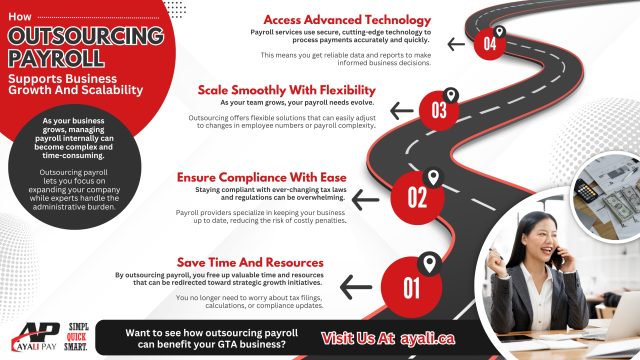Payroll providers Archives - Page 2 of 2 - Ayali Pay - Simple. Quick. Smart.
As a small business owner in Canada, managing payroll is one of the most critical tasks you will face. It involves a variety of responsibilities, from calculating wages to meeting tax obligations, and ensuring your employees are paid on time.
With the numerous rules and regulations surrounding payroll, it can be a challenging process, especially for small businesses with limited resources.
This blog will provide you with a payroll checklist to help you manage payroll without missing integral steps. By following these steps, you can maintain accuracy and stay compliant with Canadian regulations.
1. Organize Employee Information
Before processing payroll, the first step is to gather and organize all the necessary information about your employees. Accurate employee data is fundamental to calculating payroll correctly and meeting legal requirements.
Required Information:
- Employee Details: Collect full name, address, Social Insurance Number(SIN), and banking information for direct deposit purposes.
- Employment Agreement: Clearly outline whether an employee is full-time, part-time, or a contractor, along with the agreed-upon salary or hourly rate.
- Tax Forms: Have employees complete their TD1 forms(Personal Tax Credits Return), both federal and provincial, to determine the appropriate tax deductions. Keep these forms updated regularly.
Properly organizing this information will help you avoid any mistakes when calculating wages, taxes, and deductions.
2. Track Working Hours Accurately

If your business employs hourly workers, it’s essential to track their working hours accurately. This step is a vital part of making sure that employees are paid the correct amount and according to the legal standards set by Canadian law.
Tracking Methods:
- Use time-tracking software or a physical timesheet to record employee work hours each day.
- Be mindful of overtime pay for employees who work more than their regular hours. In Canada, employees are typically entitled to overtime pay of 5 timesthe regular hourly rate once they exceed 40 hours a week or as determined by provincial rules.
- Record vacation time and sick days to ensure these are factored into the payroll accurately.
By maintaining accurate records of employee hours, you can avoid costly errors and ensure compliance with labor laws.
3. Calculate Gross Pay
After collecting all the necessary employee information and tracking their work hours, the next step is calculating their gross pay. This is the total earnings before any deductions are made.
For Salaried Employees:
- If the employee is salaried, use their agreed-upon salary for the pay period. For example, if an employee earns $3,000 per month, this is their gross pay regardless of the hours worked.
For Hourly Employees:
- Multiply the number of hours worked by the employee’s hourly rate. Be sure to include any overtime pay if applicable. For instance, if an employee worked 45 hours in a week at a rate of $15 per hour, the gross pay would be $15 × 45 hours = $675. Then, calculate overtime pay at 1.5 times the regular rate for the 5 overtime hours: 5 hours × $22.50 = $112.50. The total gross pay is $675 + $112.50 = $787.50.
For Contractors:
- Contractors are paid according to the contract terms you have agreed upon. For example, if a contractor is paid $500 per project, that amount becomes their gross pay.
Having a solid understanding of how to calculate gross pay is fundamental in ensuring accuracy throughout the payroll process.
4. Apply Payroll Deductions

Once the gross pay is calculated, you must apply the required payroll deductions. In Canada, businesses are required by law to deduct federal and provincial income taxes, Canada Pension Plan (CPP) contributions, and Employment Insurance (EI) premiums. These deductions are subtracted from the gross pay, resulting in the employee’s net pay.
Common Payroll Deductions:
- Income Tax: Use the Canada Revenue Agency(CRA) tax tables to determine how much federal and provincial tax should be deducted based on the employee’s income. Each province in Canada has its own tax rates, so it’s important to refer to the appropriate table.
- Canada Pension Plan (CPP): Deductions are mandatory for employees between the ages of 18 and 70, with both the employer and employee contributing to the CPP fund.
- Employment Insurance (EI): EI premiums are also deducted from employee pay. The premium rates depend on the employee’s income level, and the maximum amount that can be deducted each year is set by the CRA.
- Other Deductions: Some businesses may also provide benefits such as health insurance, retirement savings plans, or union dues. These deductions should also be taken into account.
By applying the appropriate deductions, you help employees meet their tax obligations and contribute to social safety nets like the CPP and EI.
5. Prepare and Distribute Pay Stubs
Providing employees with detailed pay stubs is an important part of the payroll process. Pay stubs give employees a record of their earnings and deductions, and they serve as proof of payment.
What Should Be Included on a Pay Stub:
- Gross Pay: The total amount an employee earned before deductions.
- Deductions: Include federal and provincial income tax, CPP contributions, EI premiums, and any other deductions such as health insurance.
- Net Pay: The final amount the employee takes home after all deductions.
- Year-to-Date Totals: This will show the total earnings, deductions, and contributions for the year, helping employees track their progress toward tax filings.
Pay stubs also act as an important record for your business. If there is ever a payroll dispute or a CRA audit, having well-documented pay stubs will protect you.
6. Submit Payroll Taxes to the CRA

After calculating and paying employees, the next step is to remit payroll taxes to the Canada Revenue Agency (CRA). The CRA requires businesses to submit tax and contribution payments for income tax, CPP, and EI on behalf of employees.
How to Submit Payroll Taxes:
- The CRA has a set schedule for remitting payroll taxes. Depending on your business size, you may need to remit monthly, quarterly, or annually. Ensure you know your payment schedule and comply with it to avoid penalties.
- Payments can be made through the CRA’s online payment system or by mail.
- Always keep a record of these remittances and payments to safeguard your business from audits or penalties.
On-time tax remittance helps keep your business compliant with federal and provincial tax laws.
7. Year-End Reporting and Filing
At the end of the fiscal year, there are several important payroll tasks to complete, such as preparing T4 slips and filing the T4 Summary with the CRA.
Key Year-End Tasks:
- T4 Slips: Prepare T4 slips for each employee, which summarize their earnings and deductions for the year. These need to be distributed to employees by the last day of February following the end of the calendar year.
- T4 Summary: This form is filed with the CRA and includes totals for all wages, tax deductions, CPP contributions, and EI premiums.
- Record of Employment (ROE): If an employee leaves your business, you must issue an ROE. This document is essential for employees who are applying for Employment Insurance benefits.
Completing year-end reports is important for both employee tax filings and to ensure your business remains compliant with CRA regulations.
8. Stay Updated with Payroll Laws

Payroll laws and tax rates change periodically in Canada. As a small business owner, you must stay informed about these changes to avoid mistakes and penalties.
Keeping Up with Changes:
- Regularly check for updates to tax rates, CPP and EI contribution rates, and other legal requirements. The CRA is a reliable source for this information.
- Subscribe to newsletters or services that provide payroll updates.
- Work with an accountant or payroll service provider to ensure your business complies with all current laws and guidelines.
Remaining up-to-date will save you time and prevent unnecessary errors.
9. Outsource Payroll Services
Managing payroll can become complex, especially as your business grows. Outsourcing payroll services can help relieve the burden of payroll management and guarantee accuracy.
Advantages of Outsourcing Payroll:
- Time Savings: Payroll can be time-consuming. By outsourcing, you free up time to focus on other aspects of your business.
- Expertise: A payroll provider will ensure you comply with the latest laws and tax regulations.
- Accuracy: Outsourcing can reduce human errors and mistakes in tax filings or payments.
Consider outsourcing to a payroll service provider in Canada to handle the complexities of payroll and keep your business compliant.
Why Choose Ayali Pay for Your Payroll Needs
At Ayali Pay, we specialize in providing reliable payroll and payroll audit services across the GTA. If you need fully managed payroll services in Canada, we are here to support your business. With extensive experience in Canadian payroll compliance, we handle all aspects of payroll, from calculating wages to remitting taxes to the CRA.
At Ayali Pay, we offer all-inclusive payroll services in Toronto that meet the needs of small businesses and startups. Don’t let payroll stress you out; let us handle the details. Contact Ayali Pay today to learn more about our comprehensive business payroll solutions across Canada!
Conversations around engagement and retention often focus on leadership style, career development, or company culture. Yet, there’s a fundamental piece of the employee experience puzzle that frequently goes unnoticed: how—and how well—employees get paid.
In Canada, where businesses operate within a complex web of federal and provincial employment regulations, payroll is far more than a routine administrative task. It’s a critical touchpoint between the employer and employee, impacting trust, morale, and long-term loyalty.
This blog explores the deeper impact of payroll on employee satisfaction, from building confidence in HR systems to influencing retention and productivity.
The Impact of Payroll on Employee Morale

Employee morale is influenced by many factors, from company culture to compensation. However, one often overlooked factor is payroll. Employees, at the most basic level, want to be sure that they will receive their pay on time and in the correct amount. A well-managed payroll process removes the stress of administrative errors or late payments, both of which can have a significant impact on how satisfied employees feel in their roles.
When employees are confident in their payroll system, they are less likely to be distracted by financial concerns. A positive payroll experience promotes a sense of security, which can improve focus and commitment to work. On the contrary, issues such as late payments or payroll discrepancies lead to frustration and create an environment where employees feel undervalued.
This feeling of trust is integral to employee morale. Employees who feel secure in their compensation are more likely to be engaged and motivated. For example, payroll mistakes often require time to resolve, and this takes away from employees’ focus on their work. In Canada, there are specific regulations regarding payroll, including tax deductions and contributions to the Canada Pension Plan (CPP) and Employment Insurance (EI). This makes it even more essential for the payroll process to be smooth, transparent, and accurate.
Payroll and Employee Retention
Employee retention is a major challenge for businesses, and many factors contribute to whether employees stay or leave. While salary, benefits, and workplace culture often get the most attention, payroll should not be overlooked in the equation. A smooth and reliable payroll system can help improve retention rates by building trust and transparency with employees.
When payroll is accurate and employees are paid on time, they feel respected and valued. A study by Gallup found that employees who feel valued are less likely to leave their jobs. In contrast, employees who feel disrespected may begin to look for opportunities elsewhere. Payroll issues create frustration that can easily lead to dissatisfaction, and ultimately, turnover.
In Canada, where labor laws are strict and employees are entitled to a range of benefits, including vacation pay, sick leave, and health insurance contributions, businesses must remain compliant. A company that handles payroll well is more likely to retain employees for the long term, reducing the cost and disruption associated with high turnover.
Moreover, businesses that rely on small, tight-knit teams or highly skilled professionals, as is often the case with small businesses in Canada, are more sensitive to the impact of turnover. When these companies invest in well-managed payroll systems, they reduce the chance of dissatisfaction arising from payroll mistakes, ultimately improving employee retention rates.
Payroll and Productivity

One of the less-discussed but critical links between payroll and employee satisfaction is productivity. When employees do not have to worry about the accuracy or timeliness of their pay, they are free to focus on their work. Payroll errors or delays are distractions that can undermine productivity.
Think about it: if an employee’s paycheck is incorrect or delayed, they will likely spend time trying to resolve the issue. This not only takes time away from their tasks but also creates unnecessary stress. On the other hand, when employees can count on receiving accurate and timely payments, they are more likely to stay engaged and produce high-quality work.
Further, when payroll is handled right, employees are motivated to put in more effort. Studies indicate that clear and consistent communication around compensation leads to better performance. This is because employees are more focused on their roles when they feel secure and supported by their employer.
It’s not just about the paycheck itself; it’s about the assurance that comes with knowing the payroll process is dependable and error-free. By investing in reliable payroll systems, businesses can eliminate the unnecessary distractions caused by payroll issues, ultimately improving the productivity of their workforce.
Payroll and Workplace Trust
Trust is the foundation of any healthy workplace. When employees trust their employer to handle payroll matters efficiently, they are more likely to remain loyal and committed to the company. However, the overlooked role of payroll in building trust is often underestimated.
When payroll is handled correctly, employees can trust that their employer is fulfilling their financial commitments, including paying taxes, benefits, and other statutory contributions in accordance with Canadian labor laws. This transparency not only builds trust but also reduces the anxiety employees may feel about their financial future.
A transparent payroll system shows employees that their employer values their work and is committed to complying with Canadian regulations. When payroll is delayed or inaccurate, employees are left wondering about the integrity of the entire compensation system, which can erode trust and, over time, damage the employer-employee relationship.
For employers, building this trust is important for long-term success. It is far easier to retain employees who trust their employer to handle their pay fairly and promptly than to win back employees who have lost trust due to payroll issues. Moreover, a high-trust environment helps encourage collaboration and a positive organizational culture, further boosting overall company morale.
How Payroll Impacts Employee Satisfaction in Canada

Canada’s payroll system is complex, with various regulations at both the federal and provincial levels. For instance, Ontario businesses must comply with provincial employment standards, including minimum wage laws and vacation pay. These regulations add layers of complexity to payroll, and businesses that fail to comply can face significant penalties.
Ensuring that payroll is accurately calculated and compliant with all tax and employment laws is a major challenge for many businesses, particularly small enterprises. Mistakes can result in compliance issues with the Canada Revenue Agency (CRA), including costly penalties for underreporting income or failing to remit taxes on time.
Outsourcing payroll management can mitigate these risks. By working with a payroll service provider in Canada, businesses can remain compliant with the changing laws and regulations while ensuring their employees are paid correctly and on time. For small businesses in Ontario or across Canada, leveraging professional payroll services provides confidence and lets businesses focus on growth rather than administrative tasks.
The Benefits of Outsourcing Payroll for Small Businesses

Small businesses, especially those in Ontario, face unique challenges when it comes to managing payroll. With fewer resources to dedicate to HR and payroll, many small business owners struggle to keep up with the complexities of Canadian payroll law. For them, outsourcing payroll can be a game-changer.
Outsourcing payroll allows small business owners to focus on what they do best: running their businesses. Professional payroll providers offer all-inclusive payroll services in Toronto, which include not just payroll processing, but also compliance with tax laws, direct deposit, and employee record management. These services can help businesses stay on top of mandatory contributions to the CPP and EI, ensuring that employees are always paid correctly and on time.
Moreover, outsourcing payroll can save small businesses time and money. Payroll errors can result in penalties, lost employee trust, and damaged reputation. By outsourcing to a trusted payroll service provider, businesses can avoid these issues and focus on growth.
Ayali Pay—Your Partner for Professional Payroll Services
The overlooked role of payroll in employee satisfaction is clear: it directly influences morale, retention, and productivity. A smooth, timely, and accurate payroll process builds trust between employees and employers, making it an essential element of a positive work environment. Businesses that invest in reliable payroll solutions are more likely to retain top talent and ensure compliance.
At Ayali Pay, we specialize in offering payroll services in GTA that meet the needs of small and large businesses alike. Whether you’re seeking payroll outsourcing in Canada or require assistance with a CRA payroll audit in Toronto, we provide professional, hassle-free payroll services that ease the burden on your shoulders. Our services ensure that your payroll is accurate, timely, and fully compliant with Canadian regulations.
Contact Ayali Pay today to discover how we can simplify your payroll process and help your business thrive.
Navigating the world of Canadian payroll deductions can be overwhelming for many business owners. Whether you’re managing a small team or overseeing a large workforce, ensuring your payroll is compliant with government regulations is not optional—it’s essential. Mistakes in payroll deductions can lead to severe penalties, damaged employee trust, and unnecessary stress. This is why every Canadian employer must develop a clear understanding of how payroll compliance works and why leveraging business payroll solutions is crucial for operational success.
In this comprehensive guide, we’ll break down the most important aspects of Canadian payroll deductions, including mandatory contributions, their purposes, employer responsibilities, and how all-inclusive payroll services in Toronto and fully managed payroll solutions can keep your business on the right track.
What Are Payroll Deductions?
Payroll deductions are amounts withheld from an employee’s gross earnings by the employer. These deductions include mandatory with holdings such as income tax, Canada Pension Plan (CPP) contributions, and Employment Insurance (EI) premiums, among others. Employers are legally obligated to calculate, collect, and remit these amounts to the Canada Revenue Agency (CRA) within prescribed timelines.
Understanding and properly handling Canadian payroll deductions is not just about good business practice—it’s a legal requirement that ensures your company remains in full payroll compliance with the CRA.
Mandatory Canadian Payroll Deductions
Let’s break down the three core mandatory Canadian payroll deductions that every employer must understand and manage properly.
1. Canada Pension Plan (CPP) Contributions
The CPP is a federal program that provides retirement, disability, and survivor benefits to eligible workers in Canada (excluding Quebec, which has the QPP). Employers must deduct CPP contributions from employees’ pensionable earnings and match the amount dollar-for-dollar.
- Who pays it?Employees and employers (equal share)
- Why it matters:Contributes to future retirement income for employees
- When to deduct:From workers aged 18 to 69, earning over the minimum threshold
2. Employment Insurance (EI) Premiums
EI provides temporary income support to unemployed workers, those on parental or sick leave, and more. Employers must deduct EI premiums and contribute 1.4 times the employee’s contribution.
- Who pays it?Employees and employers (employer pays 1.4x employee’s rate)
- Why it matters:Supports a vital safety net for employees
- When to deduct:From most employees, with limited exceptions
3. Income Tax Withholding
Employers are responsible for deducting federal and provincial income taxes from employees’ earnings based on the total income and personal tax credits reported on their TD1 forms.
- Who pays it?Employees (employers remit it on their behalf)
- Why it matters:Supports government services and fulfills legal tax obligations
- When to deduct:Every pay period
These core deductions must be calculated accurately and remitted on time to ensure full payroll compliance and avoid CRA penalties.
The Importance of Payroll Compliance

Failing to manage Canadian payroll deductions correctly can result in serious consequences, including:
- CRA audits and assessments
- Penalties for late remittances
- Interest charges on unpaid amounts
- Damaged reputation and employee dissatisfaction
Staying on top of payroll compliance requires precise calculation, timely remittance, proper record-keeping, and a deep understanding of ever-changing CRA regulations. For many employers, this quickly becomes too complex and time-consuming to manage internally.
This is where business payroll solutions and fully-managed payroll systems come into play.
Why Use All-Inclusive Payroll Services in Canada?

Many employers are turning to all-inclusive payroll services in Canada to eliminate the stress and risk associated with managing Canadian payroll deductions. These services offer comprehensive support that covers every aspect of payroll processing, including:
- Automated payroll calculations
- CRA remittance and reporting
- Year-end T4and ROE preparation
- Employee self-service portals
- Real-time legislative updates
Choosing a fully managed payroll provider gives employers the peace of mind that every deduction is calculated correctly, every dollar is remitted on time, and every regulation is followed precisely.
Benefits of Fully Managed Payroll Solutions
- Accuracy & Timeliness: Automated systems reduce errors and ensure timely remittance of CPP, EI, and tax deductions.
- Time Savings: Free up your HR and accounting teams to focus on strategic tasks, not endless admin work.
- Expert Guidance: Payroll experts stay on top of changing CRA rules, so you don’t have to.
- Scalability: Whether you have 5 employees or 500, a fully managed payroll grows with your business.
- Enhanced Compliance: With robust audit trails, reports, and government filings, you’ll always be CRA-ready.
Common Payroll Deduction Mistakes to Avoid
Even with the best intentions and diligent efforts, employers across Canada can—and often do—make costly errors when handling Canadian payroll deductions. These mistakes not only jeopardize your company’s payroll compliance status with the CRA but can also result in financial penalties, audits, and strained employee relations.
1. Misclassifying Workers (Employee vs. Contractor)
One of the most frequent and serious payroll deduction mistakes is misclassifying individuals who perform work for your organization. Employers often mistakenly treat workers as independent contractors when they legally meet the criteria of employees. This misclassification can lead to underpayment of Canadian payroll deductions like CPP and EI, creating major issues when the CRA audits your records.
Why it matters: If you wrongly classify someone as a contractor, you’re not deducting or remitting any mandatory contributions on their behalf. Upon audit, the CRA can retroactively assess your company for unpaid deductions, interest, and penalties—which can add up quickly.
Solution: Use CRA guidelines to assess worker status correctly. If you’re uncertain, rely on a trusted fully-managed payroll provider who can guide you through proper classification.
2. Missing Deduction Start or End Dates
Employers are required to begin and end payroll deductions like CPP and EI based on specific employee conditions such as age, income level, or employment duration. Overlooking these key timelines can result in either over-deducting or failing to deduct appropriately.
Common examples: Not starting CPP deductions when an employee turns 18, continuing to deduct them after they reach 70, or begin receiving a CPP retirement pension.
Why it matters: These errors not only result in inaccurate pay and record keeping but also violate CRA regulations, putting your business at risk for non-compliance.
Solution: Automate payroll processes through business payroll solutions that flag these key milestones and ensure the correct timing of deductions.
3. Failing to Update TD1 Forms Regularly
TD1 forms determine the amount of federal and provincial tax to be withheld from an employee’s paycheck. Many employers collect these forms upon hiring but then fail to update them when an employee’s personal tax situation changes—such as marital status, dependents, or additional income sources.
Why it matters: Outdated TD1 forms can result in incorrect tax with holdings, leading to issues for both the employer and the employee during tax season. Employees may face large tax bills, and employers may be held liable for under-deductions.
Solution: Encourage employees to review and update their TD1 forms annually or whenever a major life change occurs. Better yet, work with a fully managed payroll provider that automates reminders and document updates.
4. Misapplying Provincial Tax Rates
Canada’s provinces and territories each have their income tax structures, which must be accurately applied based on the employee’s work location. Mistakes often occur when a business operates in multiple provinces or when remote employees work from a different jurisdiction than the company’s headquarters.
Why it matters: Misapplication of provincial tax rates results in inaccurate tax remittances, which can trigger CRA audits and penalties. It also leads to confusion and distrust among employees who expect their taxes to be handled properly.
Solution: Use all-inclusive payroll services in Canada that are equipped to handle multi-jurisdictional tax calculations accurately and in real-time.
5. Missing CRA Remittance Deadlines
Perhaps the most avoidable, yet frequent, mistake is failing to remit Canadian payroll deductions (CPP, EI, and income tax) to the CRA on time. The CRA enforces strict remittance schedules based on your business size and frequency of payroll. Missing a deadline—even by one day—can result in hefty penalties and interest charges.
Why it matters: Repeated failures can prompt CRA investigations, loss of good standing, and additional scrutiny of your financial practices.
Solution: Partnering with a fully managed payroll provider ensures that your deductions are remitted accurately and on time, every time, with no room for human error.
Why Avoiding These Mistakes Matters
Each of these mistakes—though common—can be costly and detrimental to your company’s credibility and cash flow. Ensuring that your business remains in good standing with the CRA requires consistent accuracy, up-to-date knowledge of payroll legislation, and a robust system for monitoring and managing payroll compliance.
This is precisely why many smart employers are turning to all-inclusive payroll services in Canada. These services remove the guesswork, reduce your administrative burden, and ensure that every aspect of your payroll, from deductions to remittances, is handled professionally and following the latest regulations.
Whether you’re scaling your operations, managing a hybrid workforce, or simply want to avoid these common pitfalls, outsourcing your payroll to a professional business payroll solutions provider is a smart and strategic investment.
Simplify Payroll with Ayali Pay
At Ayali Pay, we understand how crucial it is for Canadian businesses to manage payroll efficiently and accurately. Our all-inclusive payroll services in Canada are designed to relieve you from the burden of navigating complex Canadian payroll deductions and ensure total payroll compliance with the CRA.
Whether you’re launching a startup or running an established enterprise, our fully managed payroll solutions are tailored to your unique needs, allowing you to focus on what you do best—growing your business.
Let Ayali Pay be your trusted partner in payroll success. Contact us today to schedule your free consultation and discover how our expert team can transform your payroll operations. You can also access our online inquiry and scheduling form and get started with stress-free, compliant payroll today.
Managing payroll in Canada requires understanding and handling several important documents correctly. Whether you run a small business or a larger organization, accurate payroll documentation protects you and your employees while ensuring compliance with Canada Revenue Agency (CRA) rules.
This guide breaks down the most important Canadian payroll documents, explains when and how to issue them, and highlights common errors to avoid. We focus on clarity and practicality to help you manage payroll documentation confidently and stay compliant.
What Are Canadian Payroll Documents?
![]()
Canadian payroll documents are official forms and records that track employee earnings, deductions, and employment status for tax and government reporting. These documents include slips, statements, and records required by the CRA and provincial authorities.
These documents serve several purposes:
- Report income and deductionsto the CRA
- Inform employees about their earnings and deductions
- Support claims for Employment Insurance(EI) and other benefits
- Facilitate record keeping and audits
Understanding which Canadian payroll documents to prepare, how to complete them, and when to issue them is fundamental for all Canadian employers.
Key Canadian Payroll Documents Explained

1. T4 Slip (Statement of Remuneration Paid)
What is a T4?
The T4 slip is one of the most common Canadian payroll documents. It summarizes an employee’s total earnings and deductions for the calendar year. Employers must issue a T4 to each employee who received remuneration during the year.
The T4 reports amounts such as:
- Employment income
- CPP contributions
- EI premiums
- Income tax deducted
The CRA uses T4 slips to match reported employee income with tax returns.
When and How to Issue a T4
Employers must issue T4 slips by the last day of February following the calendar year end. T4 slips can be issued electronically or on paper. Employers also must file a T4 Summary with the CRA, summarizing all T4 slips issued.
Common Mistakes to Avoid with T4s
- Missing the deadline for issuing T4 slips or filing with CRA
- Incorrect employee Social Insurance Numbers (SINs)
- Misreporting taxable benefits or deductions
- Forgetting to include all required amounts or boxes on the slip
- Not keeping copies of issued slips and related records
Proper preparation and verification can prevent penalties and delays.
2. Record of Employment (ROE)
What is an ROE?
The Record of Employment (ROE) is a critical Canadian payroll document used when an employee stops working. It reports the employee’s work history, insurable earnings, and hours. The ROE allows Service Canada to determine the employee’s eligibility and benefit amounts for Employment Insurance (EI).
When and How to Issue an ROE
An ROE must be issued within five calendar days after the employee’s last day of work or the date the employer becomes aware that the employee has experienced an interruption of earnings.
Employers can issue ROEs electronically via the ROE Web service or on paper. The document includes important details such as:
- Reason for issuing the ROE (e.g., layoff, quit, dismissal)
- Total insurable hours and earnings
- Start and end dates of employment
Failure to issue ROEs promptly can delay EI benefits and result in compliance issues.
Common Mistakes to Avoid with ROEs
- Issuing ROEs late or not at all
- Entering incorrect employment or earnings information
- Using the wrong interruption code for the reason the employee left
- Failing to submit ROEs electronically when required
- Not providing a copy to the employee
Keeping detailed payroll records helps ensure accurate and timely ROE completion.
3. T4A Slip (Statement of Pension, Retirement, Annuity, and Other Income)
What is a T4A?
The T4A slip reports payments other than regular employment income. It is issued to contractors, pensioners, and others who receive payments such as:
- Self-employed commissions
- Pension or superannuation payments
- Other income like research grants or scholarships
When and How to Issue a T4A
T4A slips are due to recipients and the CRA by the last day of February after the tax year. Like the T4, these can be filed electronically or on paper.
Common Mistakes to Avoid with T4As
- Issuing a T4 instead of a T4A for contract payments
- Omitting payments that should be reported on T4As
- Incorrect recipient information
- Missing deadlines or not filing electronically when required
Employers and payers must carefully assess which payments require a T4A slip.
4. T2200 (Declaration of Conditions of Employment)

What is a T2200?
The T2200 is a form completed by an employer certifying that certain conditions of employment require the employee to incur expenses. It allows employees to claim work-related expenses on their personal tax returns.
When and How to Issue a T2200
Employers complete the T2200 at the employee’s request. It is not filed with the CRA but kept by the employee as proof for claiming deductions.
Common Mistakes to Avoid with T2200
- Not providing the form when requested
- Failing to accurately describe the conditions of employment
- Issuing T2200 forms too late in the tax season
Employers should keep records of T2200 requests and responses.
5. TD1 Forms (Personal Tax Credits Return)
What is a TD1?
The TD1 form is completed by employees to claim personal tax credits used by employers to calculate income tax deductions. There are federal and provincial versions.
When and How to Issue a TD1
Employers provide the TD1 forms to new employees or when employees request a change. Employees complete and return the forms, and employers use them to calculate payroll deductions.
Common Mistakes to Avoid with TD1 Forms
- Using outdated TD1 forms
- Not updating payroll deductions when employees submit new forms
- Failing to keep copies on file
Regularly check for updated TD1 forms published by CRA and provinces.
6. T5018 (Statement of Contract Payments)
What is a T5018?
The T5018 slip reports payments made to subcontractors, primarily in the construction industry. It is required for contractors to report payments to the CRA.
When and How to Issue a T5018
T5018 slips must be issued to subcontractors and filed with the CRA within 6 months after the end of the reporting period (calendar year or fiscal period) chosen by the payer. Filing electronically is mandatory for many filers.
Common Mistakes to Avoid with T5018
- Not issuing T5018 slips to subcontractors
- Reporting incorrect payment amounts
- Late filings or missing deadlines
Construction businesses should have systems in place to track and report contract payments accurately.
7. Pay Stubs (Earnings Statements)
What is a Pay Stub?
A pay stub details an employee’s earnings, deductions, and net pay for a pay period. Although not a CRA form, providing pay stubs is a legal requirement in many provinces.
When and How to Issue Pay Stubs
Pay stubs are provided with each paycheck or electronic payment. They should clearly list:
- Gross pay
- Deductions (taxes, CPP, EI, benefits)
- Net pay
- Pay period dates
Common Mistakes to Avoid with Pay Stubs
- Providing incomplete or unclear information
- Omitting required deduction details
- Failing to provide pay stubs on time
Pay stubs help employees understand their pay and deductions, building trust and reducing disputes.
When to Issue Canadian Payroll Documents: A Summary
| Document | When to Issue | How to Issue | Purpose |
| T4 Slip | By the last day of February after the tax year | Paper or electronic | Report employment income |
| ROE | Within 5 days after the employee leaves | Electronic (ROE Web) or paper | EI eligibility |
| T4A Slip | By the last day of February after the tax year | Paper or electronic | Report other income |
| T2200 | Upon employee request | Paper (kept by employee) | Certify employment expenses |
| TD1 Forms | At hire or when the employee updates their info | Paper | Calculate tax deductions |
| T5018 Slip | Within 6 months after the end of the reporting period | Paper or electronic | Report subcontractor income |
| Pay Stub | With every paycheck | Paper or electronic | Show pay and deductions |
Common Payroll Document Mistakes to Avoid
Incomplete or Incorrect Employee Information
Wrong SINs, names, or addresses can delay processing and trigger penalties. Always verify employee details at onboarding.
Missing Deadlines
CRA imposes fines for late filing or issuing of slips. Set reminders for key dates.
Mixing Up Forms
For example, paying a contractor but issuing a T4 instead of a T4A causes compliance issues.
Poor Record Keeping
Keep copies of all payroll documents for at least six years as required by CRA.
Failure to Update Forms
Ensure updated TD1 forms are used to calculate correct tax deductions.
Best Practices for Managing Canadian Payroll Documents

- Use payroll software that automates form generation and deadlines
- Train payroll staff on CRA requirements and updates
- Maintain detailed records of all payroll transactions and communications
- Regularly review payroll processes to catch errors early
- Consider outsourcing payroll to experts to reduce risk
The Role of Payroll Compliance in Canadian Business
Payroll documents are more than paperwork. They demonstrate your commitment to legal compliance and fair treatment of employees. Mistakes can lead to audits, fines, or a damaged reputation.
Canadian payroll compliance means you maintain accurate records, issue correct documents on time, and respond promptly to CRA or Service Canada requests.
Ayali Pay — Your Partner in Payroll Compliance
At Ayali Pay, we understand how managing Canadian payroll documents can be complex and time-consuming. Our all-inclusive payroll services in Toronto provide accurate, timely handling of all your payroll documentation needs. Whether you require CRA payroll audit support or payroll for small businesses in Toronto, our team ensures compliance and support.
Choose Ayali Pay for hassle-free payroll services in Toronto and Canadian payroll compliance. Contact us today to simplify your payroll and stay compliant with payroll regulations.
Payroll errors in Canada are more common than you think, and they can cost businesses dearly. These mistakes can lead to unpaid wages, employee lawsuits, government penalties, and a damaged reputation. In Ontario alone, employers owed a total of $60 million in unpaid wages between 2017 and 2024 that the government couldn’t collect.
The true cost of payroll mistakes goes far beyond dollars and cents. Below, we explore real-world case studies—many close to home in Canada—where payroll errors led to legal, financial, or reputational fallout. Each example also shares lessons on how to prevent the same from happening to you.
Case Study 1: The Phoenix Pay System Disaster (Federal Government of Canada)

One of the most infamous payroll errors in Canada wasn’t at a private company at all, but within the federal government. The Phoenix pay system, launched in 2016, was meant to streamline federal payroll. Instead, it turned into a colossal debacle. The system suffered hundreds of thousands of payroll errors, from employees being underpaid or not paid at all to others being overpaid by mistake. In fact, an estimated 62% of federal workers experienced pay errors under Phoenix.
The consequences were devastating. Some public servants drained their savings or maxed out credit cards while waiting for their missing pay. One Canadian Revenue Agency employee even saw her paycheques drop to $0 due to false “overpayment” deductions—she ultimately defaulted on her mortgage and lost her home as a result.
The financial cost to taxpayers has been enormous. The government has spent years and billions of dollars trying to fix Phoenix. As of mid-2024, the federal government had incurred about $3.7 billion in costs coping with the Phoenix fiasco. This includes hiring extra staff and technical support to sort out the mess.
On top of that, Ottawa has paid roughly $711 million in compensation to employees for stress, hardship, and other damages caused by the pay errors. Each affected worker was offered a lump sum for pain and suffering. Multiple audits and parliamentary inquiries were launched to understand how things went so wrong.
What was done to prevent future issues?
After nearly a decade of frustration, the government finally decided that enough is enough. Plans are underway to replace the Phoenix system by 2026 with a new, hopefully reliable, payroll platform. The Phoenix disaster taught a hard lesson: even large institutions need rigorous testing and oversight for payroll systems. A small glitch can snowball into a national crisis. For everyday businesses, the takeaway is clear – payroll errors in Canada can escalate quickly, so use reliable software, double-check calculations, and address issues promptly before they spin out of control.
Case Study 2: CIBC’s $153 Million Overtime Oversight

CIBC’s headquarters in Toronto. The bank faced a major class-action lawsuit over unpaid overtime, resulting in a $153 million settlement after 15 years of litigation.
One of the largest corporate payroll errors in Canada involved the Canadian Imperial Bank of Commerce (CIBC) and the mismanagement of employee overtime. The issue stemmed from CIBC’s overtime policy, which required pre-approval by managers. In practice, many front-line staff worked extra hours to serve customers but were not compensated for their overtime if it hadn’t been formally approved in advance. Essentially, the bank’s policy enabled work to be done off the clock, which violated labour standards. A CIBC teller named Dara Fresco noticed this unfair system, and in 2007, she became the representative plaintiff in a class-action lawsuit on behalf of thousands of employees.
After a protracted legal battle lasting well over a decade, the courts found CIBC had breached its overtime obligations to about 31,000 employees across Canada. Facing the likelihood of hefty damages, CIBC agreed in 2023 to settle the class-action for $153 million. The settlement money is being paid out to around 30,000 current and former tellers, personal bankers, and other staff to compensate for unpaid overtime hours over many years. Not only did this payroll mistake cost CIBC a huge sum, but it also meant years of negative press and trust issues with employees. Notably, other Canadian banks have faced similar overtime lawsuits; Scotiabank, for example, settled a case in 2014.
What can be done to prevent such issues?
To avoid legal and financial consequences, employers should implement clear and compliant overtime policies, ensure all hours worked are accurately recorded, and compensate employees for all overtime worked. Regular training for managers and the use of reliable payroll systems can further help ensure compliance with labour standards and reduce the risk of disputes.
The lesson for employers is to ensure payroll policies fully comply with labour laws and reality. If your staff end up working extra hours, you need a system to record it and make sure they get paid, period. Clear communication, proper time-tracking tools, and internal audits of timesheets can help prevent payroll errors like unpaid overtime from occurring. No company wants to be hit with a surprise multi-million dollar payout for something that was entirely avoidable.
Case Study 3: Small Businesses Fined for Unpaid Wages (Ontario)
Payroll mistakes aren’t just a big business problem. Small and mid-sized employers across Canada have also faced serious consequences for errors, sometimes with their very existence at stake. A recent example from Ontario shows how even a relatively small payroll issue can lead to legal trouble. In this case, two companies (Aemulus Corporation and Jackman Enterprises) and their director failed to pay about $85,000 in wages owed to six employees between 2019 and 2020. The employees filed complaints with Ontario’s Ministry of Labour, which investigated and ordered the companies to pay the outstanding wages. However, the employers simply ignored the orders.
Ontario authorities took them to court. The two companies and the director were hit with fines totaling $86,000 for failing to comply with the law. Under Ontario’s Employment Standards Act, ignoring an order to pay wages is an offense.
What can be done to prevent such issues?
The broader lesson for payroll errors in Canada is clear: always pay your people what they’re owed, and never ignore government orders or deadlines. Small businesses should familiarize themselves with provincial employment standards (like overtime pay rules, minimum wage, vacation pay, etc.) and set up proper payroll processes to avoid inadvertent mistakes.
If an error does happen – for example, you discover an employee wasn’t paid for overtime or a clerical mistake shorted their pay – correct it immediately. Provinces have mechanisms to file complaints anonymously, so you might not even know there’s a problem until an inspector comes knocking.
Case Study 4: Wage Underpayments at Woolworths (Australia’s $300 Million Payroll Blunder)

Payroll errors aren’t unique to Canada; companies around the world have learned the hard way how costly mistakes can be. One dramatic example comes from Australian retail giant Woolworths, which in 2019 admitted it had underpaid thousands of employees for nearly a decade. In what became Australia’s biggest wage underpayment scandal, Woolworths confessed it owed staff as much as $300 million in back pay. An internal review uncovered that at least 5,700 salaried employees (mostly department managers in supermarkets) had been shortchanged over nine years. The root cause was a payroll miscalculation: these managers were on fixed annual salaries supposedly high enough to cover any overtime, but in reality many regularly worked hours that entitled them to more pay under law than their salary provided. In short, thousands of employees were working overtime and not receiving the proper overtime or penalty rates because of wrong payroll assumptions.
The fallout was swift and serious. Woolworths’ revelation prompted a public outcry, an investigation by Australia’s Fair Work Ombudsman (the labour regulator), and accusations of “wage theft” in the media. The company’s CEO issued a public apology, stating “we have let [our employees] down” and promised to pay everyone back with interest as quickly as possible. Woolworths took a one-time charge of up to $300 million on its books to cover the remediation, which included immediate interim payments to affected staff before Christmas that year. The scandal also triggered broader industry soul-searching, with other large Australian companies auditing their own payrolls for errors. Regulators warned that companies would be held to account for such breaches even if they self-report.
What was done to prevent future issues?
Woolworths expanded its payroll review to all its business units and worked with outside auditors to identify and fix any other pay discrepancies. The company overhauled its compliance systems and committed to ensuring all managers’ salaries at least meet minimum award (overtime) requirements going forward.
The clear takeaway for employers everywhere is that payroll errors can lurk for years if you’re not careful, especially when dealing with complex overtime and salary structures. Regular audits, whether internal or by a third party, are essential. Make sure any “all-inclusive” salaries truly cover all the hours worked, or else track overtime and pay it out. What started as small calculation errors at Woolworths snowballed into hundreds of millions in liabilities. No business, in Canada or elsewhere, can afford that kind of mistake.
Why Ayali Pay Is Your Trusted Choice
You’ve seen how payroll errors in Canada and beyond can wreak havoc—from massive legal settlements to broken trust and burned finances. The good news is, you don’t have to navigate these payroll minefields alone. Ayali Pay is here to help your business get payroll right every time. We offer hassle-free payroll services in Toronto that businesses can rely on, with end-to-end support that ensures your employees are paid accurately and on schedule. Our expert team stays on top of Canadian payroll compliance rules, so you won’t lose sleep over CRA audits or missing remittances. Whether you’re a small startup or a growing company, Ayali Pay provides fully managed payroll services in Canada to eliminate errors and keep you on the right side of the law.
The true cost of payroll errors is one risk you don’t need to take. Let Ayali Pay save you time, protect your business from costly mistakes, and give you the confidence that your payroll is in the best hands. Contact us today!
Remote work has reshaped how businesses operate across Canada. The rise of hybrid and fully remote teams means companies often have employees working from different provinces and territories. Managing payroll for this distributed workforce brings new challenges. Payroll must comply with various federal and provincial laws, tax rules, and reporting requirements.
In this blog, you will find a clear and professional guide to handling payroll for remote teams in Canada. The focus is on understanding:
- The challenges of cross-provincial payroll
- Tax implications for remote employees
- The benefits of cloud-based payroll systems
This information helps businesses avoid errors, remain compliant, and provide fair, timely pay to their remote workforce.
Cross-Provincial Payroll Challenges in Canada
Canada’s federal system divides payroll responsibilities between the federal government and the provinces. This means payroll managers must navigate a complex set of regulations, rates, and remittance rules when employees work in different provinces.
1. Understanding Provincial Income Tax Withholding
In Canada, income tax is collected by both the federal government and the provinces or territories. Each province has its own tax rates and credits, which means payroll withholding must be adjusted depending on the employee’s work location.
- Federal Tax:Uniform across Canada, deducted based on CRA tables.
- Provincial Tax:Varies by province; payroll must withhold according to the employee’s physical location.
For example, Quebec has its own provincial tax system and collects provincial taxes separately from the federal government. Employers with employees in Quebec must withhold provincial income tax directly to Revenu Québec rather than the CRA.
If an employee works remotely from multiple provinces within a year, payroll systems must adapt. Employers need to:
- Track where employees are working on a day-to-day or monthly basis.
- Adjust provincial tax deductions accordingly.
- Update payroll records when employees permanently change provinces.
Payroll accuracy is critical. Incorrect provincial tax deductions may cause employees to face unexpected tax bills or refunds at year-end and could trigger CRA compliance reviews.
2. Provincial Payroll Contributions and Levies
In addition to income tax, many provinces impose payroll contributions that employers must handle.
- Health Premiums or Levies:Some provinces, such as British Columbia and Ontario, have health premiums or similar levies that must be deducted or paid by employers on behalf of employees.
- Workers’ Compensation Board (WCB) Contributions:Each province manages its own WCB program, which provides workplace injury insurance. Employers register with the WCB in provinces where their employees work and remit contributions based on payroll and industry risk.
- Employment Insurance (EI):Though EI is federally regulated, contribution rates can vary slightly based on provincial maximums.
Employers with remote teams must register with multiple provincial agencies and handle each contribution according to the province’s rules. Failure to do so could lead to penalties or delayed employee benefits.
3. Employment Standards: Vacation, Statutory Holidays, and Termination Pay
Employment standards legislation in Canada is province-specific. Payroll managers must understand and apply the correct rules related to:
- Vacation Pay:Minimum vacation entitlements vary. For instance, Ontario requires at least two weeks of paid vacation, whereas some provinces set minimums at four percent of earnings.
- Statutory Holidays:Provinces differ in the number and names of statutory holidays recognized. Employers must pay holiday pay or substitute days accordingly.
- Termination Pay:Notice periods and severance pay vary provincially and must be reflected accurately in final payroll calculations.
When managing payroll for remote workers in different provinces, payroll teams need to be familiar with each jurisdiction’s employment laws to comply properly.
4. Payroll Reporting, Remittances, and Record-Keeping
Employers must submit payroll deductions and employer contributions to the CRA and provincial authorities on schedule. Reporting includes:
- Payroll tax remittances (income tax, CPP, EI) to CRA monthly or quarterly.
- Workers’ compensation payments to respective provincial boards.
- Provincial health premiums or levies as required.
Employers must also prepare and file T4 slips that show income and deductions, ensuring they reflect the employee’s provincial location correctly.
Handling multiple provinces means managing several accounts, meeting different deadlines, and ensuring records meet local requirements. These challenges increase the administrative burden.
Remote Work Tax Implications in Canada

Remote work arrangements present several unique tax considerations that affect payroll compliance.
1. Employee Tax Residence and Work Location
In general, the employee’s tax residence and place of employment determine payroll tax obligations.
- If an employee works remotely full-time from a province, the employer must apply that province’s tax and employment rules, even if the company is based elsewhere.
- For employees who work in multiple provinces throughout the year, payroll managers should allocate wages earned in each province and apply the corresponding tax rates.
CRA guidance confirms that withholding depends on the employee’s place of work, not solely on the employer’s location.
2. Taxable Benefits Related to Remote Work
Remote employees often receive reimbursements or allowances for expenses such as:
- Home office supplies
- Internet and phone costs
- Equipment (computers, chairs, desks)
Employers must classify these reimbursements correctly. The CRA distinguishes between:
- Non-taxable reimbursements:Direct payment for reasonable business expenses that employees incur.
- Taxable benefits:Items that provide personal benefits or exceed CRA limits.
Incorrectly treating taxable benefits as non-taxable could lead to payroll errors and penalties.
Employers should:
- Keep clear documentation of expenses.
- Communicate policies on remote work reimbursements to employees.
- Adjust payroll to include taxable benefits when required.
3. Permanent Establishment and Corporate Tax Risks
A remote employee working in a province without a corporate presence could create a permanent establishment for the employer. This means the company might be subject to provincial corporate income tax.
Factors determining permanent establishment include:
- The employee’s authority to conclude contracts in the province.
- Duration and nature of business activities conducted remotely.
Employers should consult tax advisors to assess whether remote employees create permanent establishments and prepare for associated tax obligations.
4. Employment Insurance (EI) and Canada Pension Plan (CPP) Considerations
Employers must deduct EI and CPP contributions based on the employee’s province of residence. Contribution rates and maximums can differ slightly by province.
Payroll teams need to:
- Stay current on annual contribution limits and rates.
- Update payroll systems as CRA and provincial parameters change.
- Ensure accurate year-end reporting for employee CPP and EI contributions.
Cloud-Based Payroll Tools for Remote Teams in Canada

Managing multi-provincial payroll manually is complex and prone to errors. Cloud-based payroll platforms simplify the process by automating calculations, tax deductions, reporting, and compliance.
1. Centralized Management Across Provinces
Cloud payroll solutions let you:
- Manage employee records from a single dashboard regardless of their work location.
- Automatically calculate provincial tax withholdings based on employee addresses or work locations.
- Update tax rates in real time as CRA or provincial authorities adjust tables.
This centralization reduces risk, saves time, and improves payroll accuracy.
2. Automated Filing and Payment
Leading cloud payroll platforms connect directly to the CRA and provincial agencies to:
- File remittances automatically on behalf of employers.
- Generate and submit T4 slips and related year-end documents.
- Provide digital pay stubs and tax forms to employees securely.
Automation cuts down on late filings, penalties, and manual paperwork.
3. Compliance Alerts and Audit Preparation
Good payroll software monitors compliance changes and alerts payroll managers to updates in tax laws or provincial regulations.
Features often include:
- Automated audits of payroll data to catch discrepancies.
- Easy export of data for CRA audits or trust examinations.
- Record-keeping tools to demonstrate compliance during CRA payroll examinations.
4. Integration with HR and Accounting Systems
Cloud payroll platforms commonly integrate with HR management, time tracking, and accounting software. This:
- Minimizes data entry errors.
- Ensures consistency across systems.
- Enables easier tracking of remote work schedules and locations.
5. Employee Self-Service
Many platforms offer portals where remote employees can:
- Access pay stubs and tax slips anytime.
- Update personal and work location information.
- Request time off or manage benefits.
This reduces administrative questions and improves employee satisfaction.
Best Practices for Managing Payroll for Remote Teams in Canada

Effective payroll management for remote and hybrid teams requires consistent processes and attention to detail.
1. Maintain Accurate Employee Location Records
It is essential to:
- Collect initial work location data at hiring.
- Require employees to notify HR or payroll if their location changes.
- Track temporary work-from-different-province arrangements carefully.
Accurate location data ensures correct provincial tax deductions and employment law compliance.
2. Regularly Review Payroll Deductions and Provincial Contributions
Payroll administrators should:
- Conduct periodic audits of tax deductions and provincial remittances.
- Update employee records and payroll setups when employees relocate.
- Verify that vacation pay, statutory holidays, and employment standards match the employee’s province.
3. Invest in a Reliable Cloud-Based Payroll Solution
Choose payroll software that supports:
- Multi-provincial payroll with real-time tax updates.
- Automated filings to CRA and provincial agencies.
- Employee self-service and mobile access.
- Integration with HR and accounting tools.
4. Communicate Payroll Policies Clearly
Employees should understand:
- How remote work affects their payroll deductions.
- Which reimbursements are taxable or non-taxable.
- Who to contact for payroll questions.
Clear communication reduces payroll disputes and confusion.
5. Stay Current with CRA and Provincial Updates
Tax laws and employment standards change regularly. Employers should:
- Subscribe to CRA newsletters and provincial government updates.
- Attend payroll seminars or webinars.
- Consult payroll professionals when in doubt.
6. Prepare for CRA Payroll Audits and Trust Examinations
CRA conducts audits and trust examinations to verify payroll compliance. Employers should:
- Keep detailed payroll records for all employees.
- Document all payroll policies and employee communications.
- Use payroll tools that generate audit-friendly reports.
Addressing Payroll Challenges for Seasonal or Mobile Remote Workers

Some businesses have employees who work remotely but travel frequently between provinces. Examples include:
- Sales representatives
- Field service workers
- Consultants
Payroll for these workers requires:
- Accurate time tracking by location.
- Allocating wages earned per province.
- Applying appropriate tax and employment standards for each work period.
Cloud payroll systems that integrate with time tracking tools can simplify these calculations.
Understanding CRA Payroll Audits and Their Importance
CRA payroll audits, also known as payroll examinations, verify employer compliance with tax withholding and remittance requirements.
- Audits can focus on employment classification, benefit reporting, and tax deductions.
- Remote work and cross-provincial issues often attract CRA attention due to complexity.
- Maintaining accurate payroll records and using compliant payroll systems reduces audit risks.
Employers should cooperate fully with CRA during audits and use them as opportunities to improve payroll practices.
Payroll for Remote Teams in Canada: Key Takeaways

- Canada’s provincial payroll rules require employers to carefully manage cross-provincial tax deductions, employment standards, and remittances.
- Remote work shifts the employee’s work location, which often dictates payroll tax obligations.
- Taxable benefits for remote work must be handled correctly to avoid payroll errors.
- Cloud-based payroll platforms provide automation, compliance monitoring, and multi-provincial support that simplify payroll management.
- Keeping accurate employee location records and communicating payroll policies clearly is vital.
- Preparing for CRA payroll audits and examinations through sound record-keeping and software tools is essential.
Ayali Pay – Your Trusted Partner in Payroll Compliance
Ayali Pay delivers expert payroll services tailored for companies in Toronto managing remote and hybrid teams. Our all-inclusive payroll services in Toronto cover everything from CRA trust examinations in GTA to payroll audits, helping you stay compliant and confident.
With fully managed payroll service provider in Canada, Ayali Pay removes the complexity of cross-provincial payroll tax remittances, deductions, and reporting. We offer transparent, hassle-free payroll services in Toronto, designed to meet the needs of small and large businesses alike.
If you seek reliable Canadian payroll compliance and efficient Toronto payroll solutions, contact Ayali Pay today for trusted support that keeps your payroll accurate, timely, and audit-ready.
Managing payroll is one of the most critical tasks in any business. Whether you run a small company in Toronto or a growing business anywhere in Canada, how you handle payroll can affect your compliance, employee satisfaction, and operational efficiency. You might be wondering if it’s better to keep payroll management in-house or to outsource it to a professional provider. In this blog, we will discuss the pros and cons of payroll outsourcing vs. in-house management with a focus on Canadian business environments. By understanding the practical, financial, and legal factors involved, you can make a practical decision.
What Is Payroll Outsourcing?

Payroll outsourcing means hiring an external company to manage your payroll process. These providers take care of calculating employee pay, deducting taxes, filing government reports, and ensuring legal compliance with the Canada Revenue Agency (CRA) and provincial authorities. They also often handle direct deposits, benefits administration, and year-end tax forms such as T4s.
For many Canadian businesses, outsourcing payroll reduces the administrative workload and shifts the responsibility of accuracy and compliance to experts.
What Does In-House Payroll Management Mean?
In-house payroll management means your company’s staff handles payroll activities. This might involve an HR or accounting professional who processes payroll manually or using software, deducts taxes, submits payments, and manages payroll records.
In-house payroll can give you full control over your payroll data and processes. However, it requires investing in software, staff training, and dedicating time to stay current with Canadian payroll laws.
Cost Comparison
Cost often weighs heavily in the decision between payroll outsourcing vs. in-house management.
Costs When Outsourcing Payroll
Outsourcing typically comes with a monthly or per-payroll fee based on the number of employees. Fees usually cover software access, tax remittance, government reporting, direct deposit, and support.
While it might seem like an ongoing expense, outsourcing removes the need for costly payroll software purchases and updates. It also reduces the risk of errors that can result in penalties or costly corrections.
In-House Payroll Costs
In-house payroll involves buying payroll software licenses and maintaining them. You also pay salaries for employees who manage payroll and spend time training them on compliance and software use.
Indirect costs like managing mistakes, handling audits, or correcting filings can add to the overall expense. Smaller businesses without dedicated payroll staff might find that these costs quickly add up.
Compliance with Canadian Payroll Laws

Payroll compliance in Canada can be complex. The CRA enforces strict rules on payroll tax deductions, remittances, and record-keeping. Mistakes can result in audits, penalties, and interest charges.
Staying compliant means understanding both federal and provincial payroll laws, which can frequently change and require close attention.
Outsourcing and Compliance
Payroll outsourcing companies specialize in Canadian compliance. They monitor updates to federal and provincial tax laws, employment standards, and reporting deadlines. Their expertise helps reduce errors and avoid costly penalties.
Outsourcing providers often support businesses during CRA payroll audits and trust examinations in Toronto, helping navigate government reviews with ease.
In-House Compliance
When payroll compliance is managed internally, your team must keep up with legislative changes and CRA updates continuously. Payroll staff or administrators need to review new rules regularly and implement required changes in payroll calculations and reporting.
For smaller teams without specialized knowledge, this responsibility can be challenging and increase the risk of mistakes. Such errors may trigger audits, cause late filings, or result in fines, which can disrupt business operations and damage reputations.
Security of Payroll Data

Payroll involves handling sensitive employee information, including social insurance numbers, banking details, and salary data. Protecting this information from unauthorized access or breaches is a priority for any business. Improper handling can lead to data theft, legal issues, and loss of employee trust.
Outsourcing Data Security
Established payroll providers invest in secure technology, encryption, and access controls. They follow Canadian privacy laws like the Personal Information Protection and Electronic Documents Act (PIPEDA), reducing the risks of breaches from internal mishandling.
That said, it is important to select a trustworthy provider with transparent security policies and safeguards.
In-House Data Security
Keeping payroll in-house means you control data storage and access. This requires a strong internal IT infrastructure, strict access permissions, and ongoing monitoring.
Smaller businesses may find it difficult to maintain the necessary level of security without dedicated IT support.
Level of Control
Your preference for managing payroll processes impacts your choice.
Control When Outsourcing
Outsourcing shifts some control to the provider. While providers manage the day-to-day payroll activities, many offer portals for employers to review payroll reports, approve payments, and track compliance.
This reduces administrative burden but also means relying on the provider’s schedules and processes.
Control When In-House
In-house payroll gives you full authority over the process. You can respond quickly to special payroll situations, customize pay runs, and directly manage employee data.
However, full control also means full responsibility for accuracy, timing, and compliance.
Ability to Scale
As your business grows, payroll demands increase. The ease of scaling payroll affects which option is more suitable.
Outsourcing and Growth
Payroll outsourcing providers easily handle growth. They accommodate new employees, multiple locations, and different provincial tax rules without requiring extra internal resources.
This flexibility supports expanding companies with evolving payroll needs.
In-House Payroll and Growth
Growing in-house payroll requires hiring more staff, upgrading software, and possibly expanding administrative hours. This can slow down payroll operations and increase overhead costs.
Many businesses find internal payroll less flexible to adjust as rapidly as growth demands.
Technology and Automation
![]()
Payroll accuracy and speed depend heavily on technology.
Payroll Providers’ Technology
Outsourcing companies use cloud-based platforms that automate pay calculations, tax filings, and remittances. They provide employee self-service portals for payslip access and tax forms.
Providers handle software updates and security, allowing you to focus on other business functions.
In-House Technology Needs
Managing payroll in-house requires you to purchase, install, and maintain payroll software. You must apply updates, troubleshoot issues, and ensure integration with accounting systems.
Without IT expertise, technology problems can delay payroll and increase errors.
Impact on Employee Experience

Payroll is an employee-facing function. Timely payments and easy access to pay information matter.
Outsourced Payroll and Employees
Outsourcing often comes with portals where employees can securely view payslips, tax documents, and benefits information. This reduces administrative questions and builds transparency.
In-House Payroll and Employees
In-house payroll teams can address employee payroll questions directly, offering a personal touch. However, they may lack digital self-service tools, requiring manual handling of requests.
Risk and Accountability
Payroll errors can have legal and financial consequences.
Outsourcing Risk Management
Payroll providers take on much of the risk related to errors. They often offer guarantees or insurance for mistakes and assist with audit defense, minimizing your exposure.
In-House Risk Management
With internal payroll, your company is fully responsible for any mistakes, delays, or compliance breaches. This increases exposure to CRA audits and possible fines.
Which Option Fits Your Business?

Payroll Outsourcing Works Best If You:
- Are a small or medium-sized business without payroll specialists
- Want to reduce administrative tasks
- Need to comply with complex Canadian payroll regulations
- Plan to grow or operate in multiple provinces
- Prefer to use advanced payroll technology without managing software
In-House Payroll Suits You If You:
- Run a larger business with a dedicated payroll or HR team
- Have complex payroll requirements needing close control
- Possess the resources to manage compliance and technology
- Prefer direct control over employee data and payroll timing
Key Points on Payroll Outsourcing vs. In-House Management
| Aspect | Payroll Outsourcing | In-House Payroll |
| Cost | Fixed fees; avoids software and training costs | Software licenses, salaries, and training expenses |
| Control | Shared control; provider manages day-to-day | Full control and responsibility |
| Scalability | Handles growth and expansion easily | Limited by internal staff and resources |
| Data Security | Professional security systems | Internal control needed; may lack resources |
| Technology | Cloud-based platforms maintained by provider | Own responsibility for software maintenance |
| Employee Access | Employee portals provided | May lack self-service options |
Choose Ayali Pay for Your Payroll Needs
When weighing payroll outsourcing vs. in-house management, Ayali Pay offers reliable and comprehensive solutions designed for Canadian businesses. Whether you’re based in Toronto or the broader GTA, our expert payroll services and compliance support ensure your operations stay aligned with CRA regulations.
Our team provides guidance through CRA payroll and trust examinations in Toronto, helping reduce stress during audits. Ayali Pay’s all-inclusive Toronto payroll services handle everything from tax remittances to employee payments, so you can focus on growing your core business.
Choose Ayali Pay as your trusted payroll service provider in Canada for reliable business payroll solutions, payroll outsourcing, and payroll tax services. Visit our online inquiry form to contact us and schedule your free consultation—let our Toronto-based experts take payroll off your plate.
Human resources (HR) management plays an important part in every business. It covers hiring, payroll, employee relations, and following labour laws. Still, many
Canadian companies face costly problems due to HR errors. These HR mistakes that cost businesses thousands often lead to fines, legal trouble, and loss of trust. Most of these can be avoided by applying the right knowledge and procedures.
In this blog, you will learn about the most frequent and expensive HR mistakes in Canada. From miscalculating overtime pay to handling terminations improperly, knowing these risks helps you protect your business. You will also find guidance on how to keep your HR practices within the law to avoid financial losses.
Mismanaging Overtime Pay
Overtime pay issues are a common cause of HR disputes across Canada. The Canada Labour Code and provincial employment standards require most employees to receive overtime pay for hours worked beyond the standard workweek, usually 40 hours. The overtime rate is generally 1.5 times the regular hourly wage.
Incorrectly calculating overtime or failing to pay it can result in back pay owed to employees, penalties, and even lawsuits. Misclassification of workers or poor time tracking often causes these problems. Small businesses, especially, may face challenges managing overtime without proper systems.
To avoid this HR mistake that costs businesses thousands, it is important to:
- Keep detailed and accurate records of hours worked.
- Review employee classifications regularly.
- Use payroll software that automatically calculates overtime based on hours.
- Stay informed about overtime rules for the province or territory where you operate.
Applying these measures helps reduce errors in overtime payment and lowers the risk of costly claims.
Incorrect Employee Classification

Another expensive HR error is misclassifying employees as independent contractors. Some businesses try to reduce payroll taxes and benefits costs by labeling workers as contractors. However, Canadian labour laws apply tests based on the level of control, ownership of tools, and integration into the business to decide classification.
If an employee is wrongly classified, the employer may face orders to pay unpaid wages, taxes, benefits, and penalties. The Canada Revenue Agency (CRA) often investigates businesses on this issue, which can lead to audits and financial penalties.
To avoid this HR mistake that costs businesses thousands:
- Understand the criteria used to determine employee vs. contractor status.
- Keep clear documentation of work arrangements.
- Seek expert advice before making classification decisions.
- Adjust payroll and tax filings based on the correct classification.
Correct classification protects your business from future tax and legal liabilities.
Mishandling Employee Terminations

Terminating employees improperly is a major source of costly disputes in Canadian workplaces. Wrongful dismissal claims arise when employers fail to provide proper notice, severance pay, or follow correct procedures.
Key points to consider during terminations include:
- Confirm if termination is with cause or without cause.
- Provide statutory notice or pay instead of notice.
- Account for contractual or collective agreement obligations.
- Keep records of the steps taken in the termination process.
Failure to comply with these requirements can lead to lawsuits, damages, and legal fees, making this one of the most expensive HR mistakes that cost businesses thousands.
Non-Compliance with Employment Standards
Each province and territory has employment standards laws that set minimum requirements for wages, hours, vacation, leaves, and more. Businesses that do not
follow these laws risk fines and legal challenges.
Examples of common non-compliance issues include:
- Not granting paid sick leave when required.
- Failing to pay employees for statutory holidays.
- Ignoring entitlements to maternity or parental leave.
These mistakes often result from a lack of training or outdated policies. Staying informed about provincial labour standards and adjusting policies regularly helps avoid these costly problems.
Poor Record Keeping

Keeping accurate employee records is a legal obligation in Canada. Good record keeping supports payroll accuracy and protects employers in case of disputes or audits.
Employers must maintain records on:
- Hours worked.
- Pay and deductions.
- Leave taken.
- Terminations and disciplinary actions.
Failure to keep proper records can result in penalties and weakened legal defences, adding to the cost of HR mistakes that cost businesses thousands.
Inadequate Workplace Health and Safety Practices
Workplace safety rules are enforced strongly across Canada by provincial agencies like Ontario’s Ministry of Labour or WorkSafeBC. Non-compliance can lead to fines, work stoppages, and higher insurance premiums.
Common safety errors include:
- Skipping required safety training.
- Not investigating incidents thoroughly.
- Ignoring employee concerns about hazards.
A workplace without proper safety measures risks accidents, compensation claims, and loss of reputation—all of which can be expensive.
Errors in Employee Benefits Administration
Benefits like group insurance, pension plans, and paid time off involve strict rules. Mismanaging benefits plans or contributions risks penalties and employee dissatisfaction.
For example, mistakes in Canada Pension Plan (CPP) or Employment Insurance (EI) remittances can trigger CRA audits. Poor benefits management also affects employee morale and retention.
Avoiding this HR mistake that costs businesses thousands requires understanding benefits regulations and managing them with care.
Insufficient Training for HR and Managers

Many HR mistakes result from a lack of training for HR staff and managers. When those responsible for hiring, managing, and terminating employees lack a solid understanding of employment law and best practices, the risk of errors increases significantly. Managers may unintentionally violate labour laws, mishandle employee relations, or misinterpret company policies. These mistakes often lead to legal disputes, fines, and lost productivity.
Beyond the legal aspects, inadequate training can also harm workplace morale. When managers are unsure how to handle conflict, performance issues, or complaints properly, employees may feel unsupported or unfairly treated. This can lead to higher turnover rates, absenteeism, and decreased engagement—all of which carry financial consequences.
Regular and targeted training sessions focused on labour standards, payroll regulations, workplace harassment, and termination procedures help reduce these risks. Training should be updated frequently to reflect changes in legislation and emerging best practices. Additionally, companies can consider using external experts to deliver workshops or provide ongoing support, ensuring HR teams and managers stay informed.
Ignoring Human Rights and Inclusion Requirements
Canada’s human rights legislation is designed to protect employees from discrimination and harassment based on protected grounds such as race, gender, age, disability, religion, and more. Ignoring these legal obligations or failing to take complaints seriously can result in costly human rights claims against businesses. Such complaints may lead to financial penalties, mandatory corrective actions, and significant damage to the company’s reputation.
A common HR mistake is neglecting to accommodate employees’ needs as required under human rights laws. For example, failing to provide workplace adjustments for disabilities or ignoring requests for religious accommodations can trigger legal challenges. Employers are expected to act promptly and reasonably to address these needs, and create an inclusive environment where all employees can perform their best.
Furthermore, overlooking harassment complaints, whether related to bullying, sexual harassment, or discrimination, can expose the business to costly lawsuits and workplace disruption. Employers must have clear policies, accessible reporting mechanisms, and follow-up procedures that protect complainants and ensure fair investigations.
Accessibility requirements also play an important role. Businesses must ensure that their facilities, tools, and communication methods do not exclude individuals with disabilities. Non-compliance with accessibility standards can lead to fines and increased liability.
How to Reduce Risks and Avoid HR Mistakes

Businesses can limit costly HR mistakes by taking the following steps:
- Use payroll and HR systems that accurately manage overtime, classifications, and statutory deductions.
- Keep thorough and organized employee records.
- Provide ongoing training to HR staff and managers on labour laws and company policies.
- Consult legal or HR experts before significant actions such as terminations or reclassifications.
- Monitor changes in federal and provincial employment standards.
- Maintain clear, written policies reflecting current laws.
Applying these steps helps businesses avoid financial losses and maintain workplace fairness. The most frequent HR mistakes that cost businesses thousands in Canada include mishandling overtime pay, misclassifying workers, improper terminations, non-compliance with employment standards, and poor record keeping. Other costly issues involve workplace safety, benefits administration, insufficient training, and ignoring human rights rules. By improving HR procedures and keeping policies updated, businesses can reduce the risk of penalties, lawsuits, and reputational damage.
Why Ayali Pay Is Your Trusted Partner for Payroll and Compliance
Managing payroll in Toronto can be difficult. Ayali Pay offers expert payroll services in Toronto, designed to help businesses stay within the law and avoid costly HR errors. Our services include CRA payroll audit and CRA payroll examination services in Toronto, offering expert assistance during government reviews.
With Ayali Pay, you receive fully managed payroll services in Canada, relieving your business of administrative burdens. Whether you need payroll services for small businesses in Toronto or need hassle-free payroll services in GTA, Ayali Pay delivers reliable support.
Schedule your free consultation today through our online form and discover how our trusted Toronto payroll solutions can help protect your company from costly mistakes.














